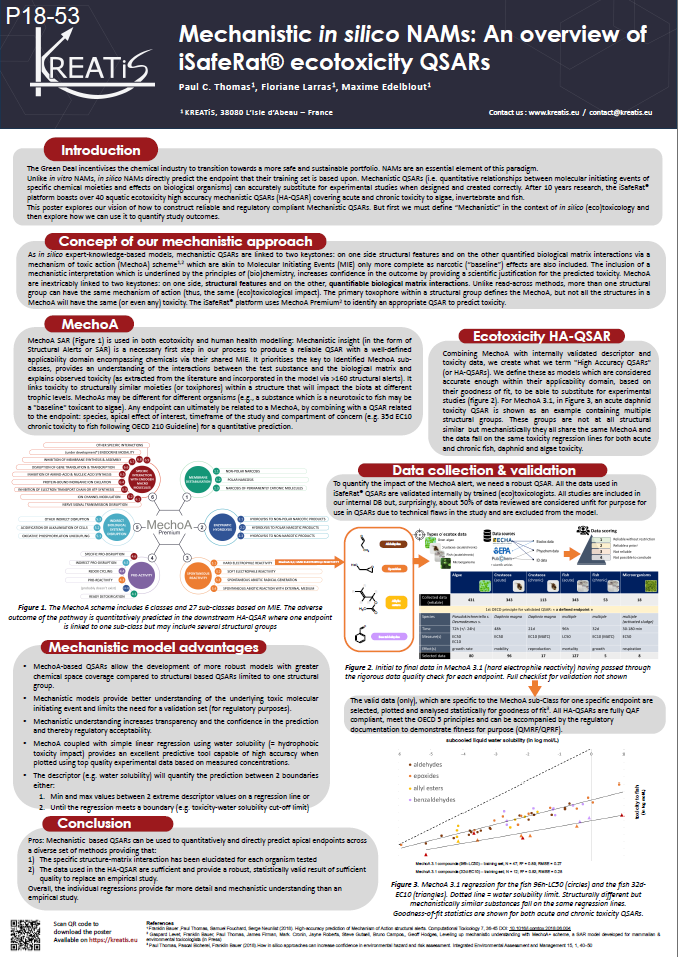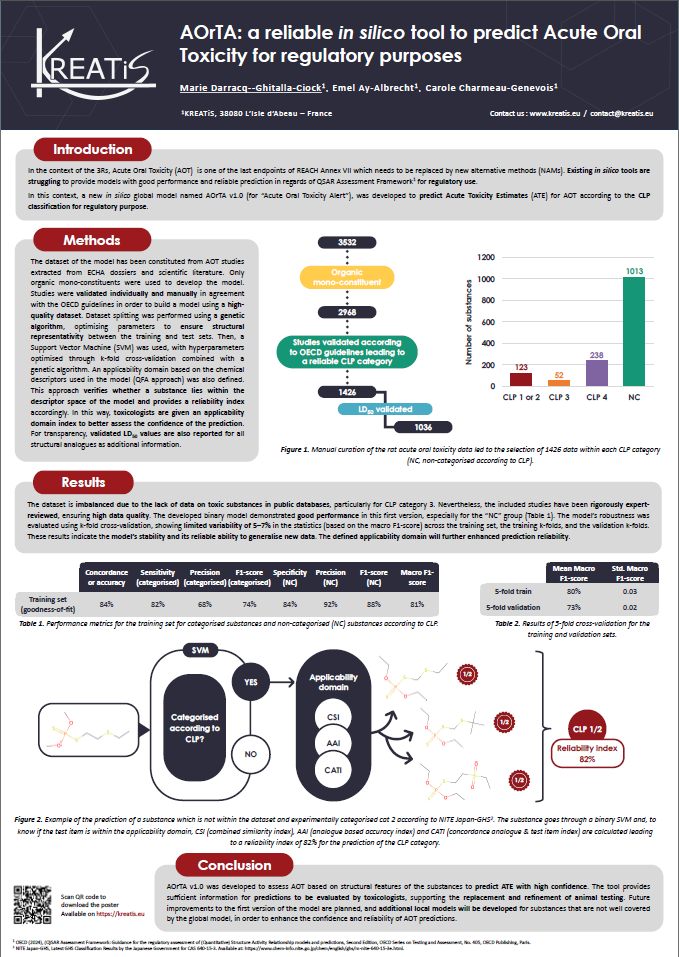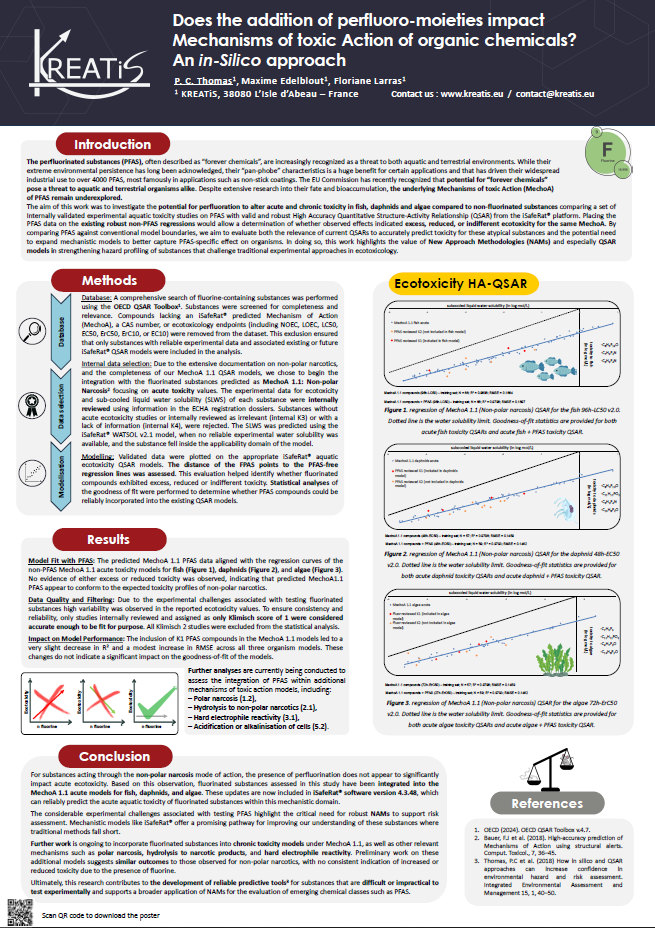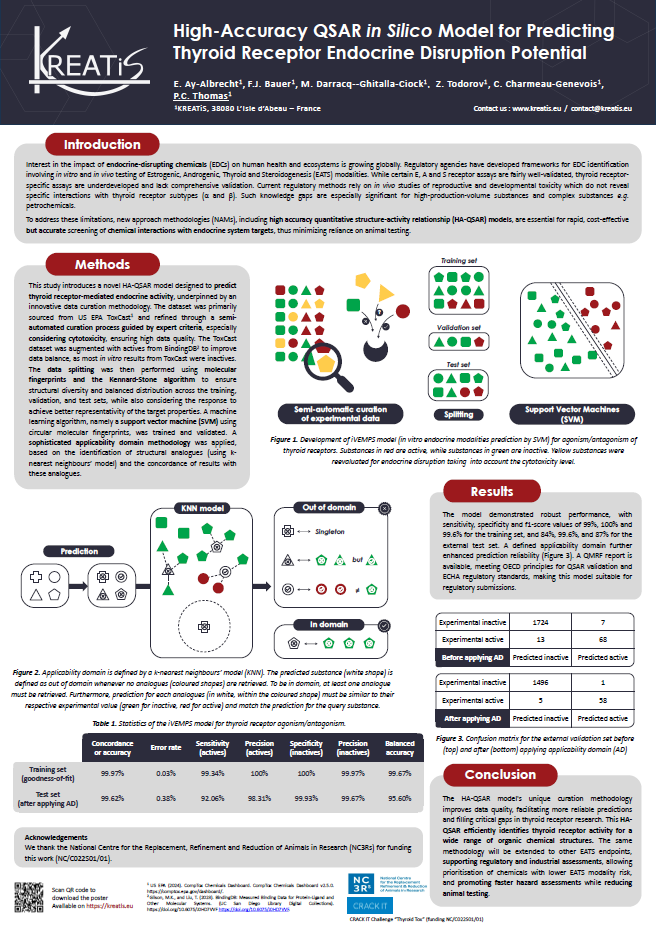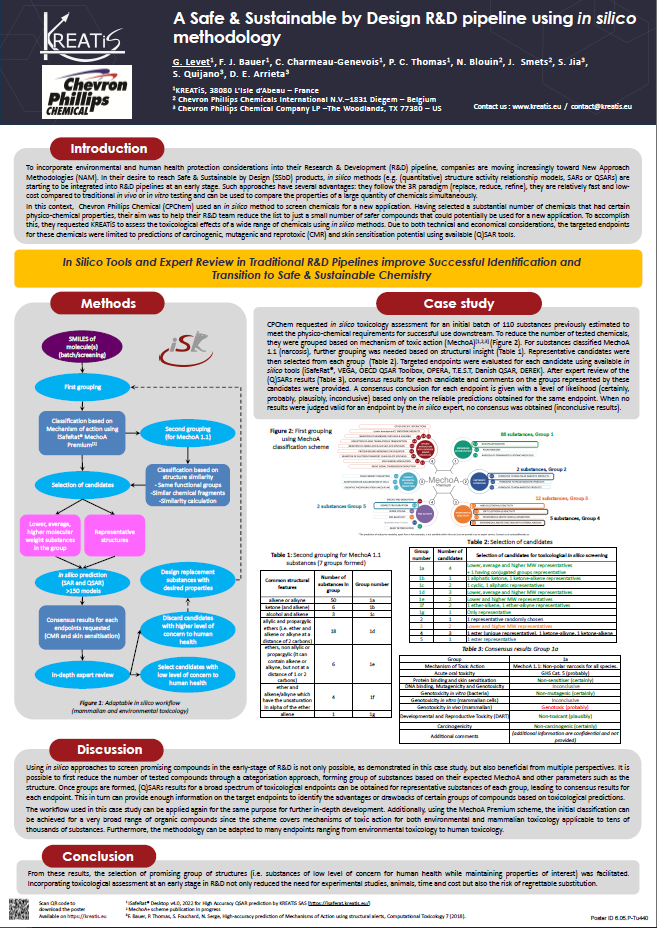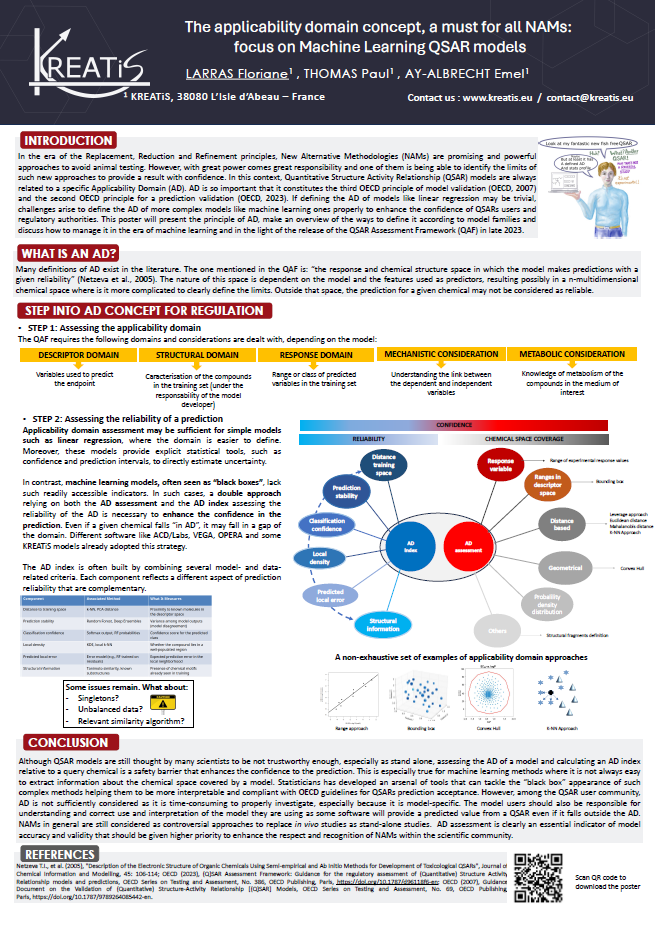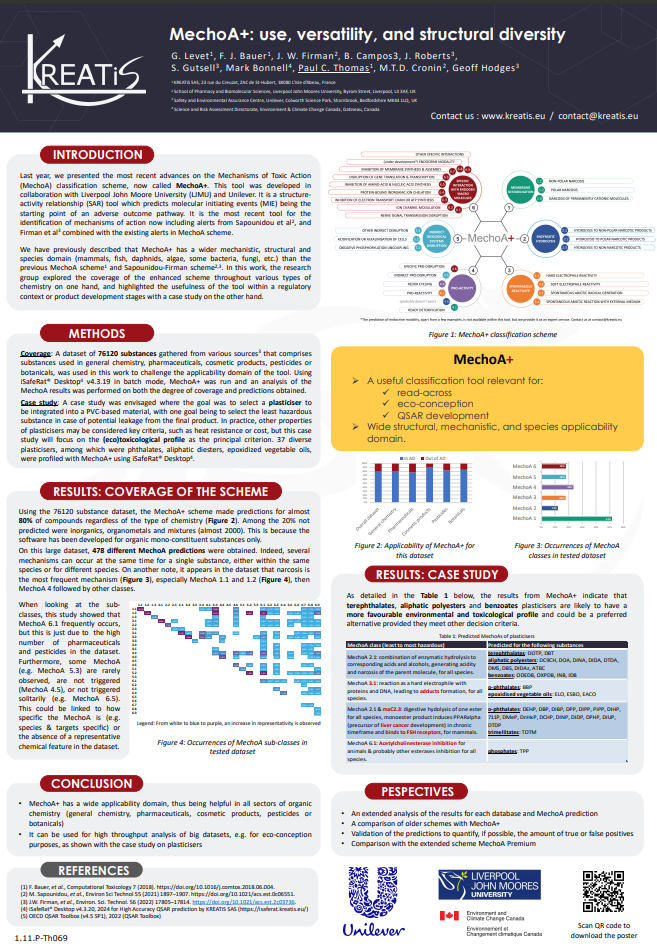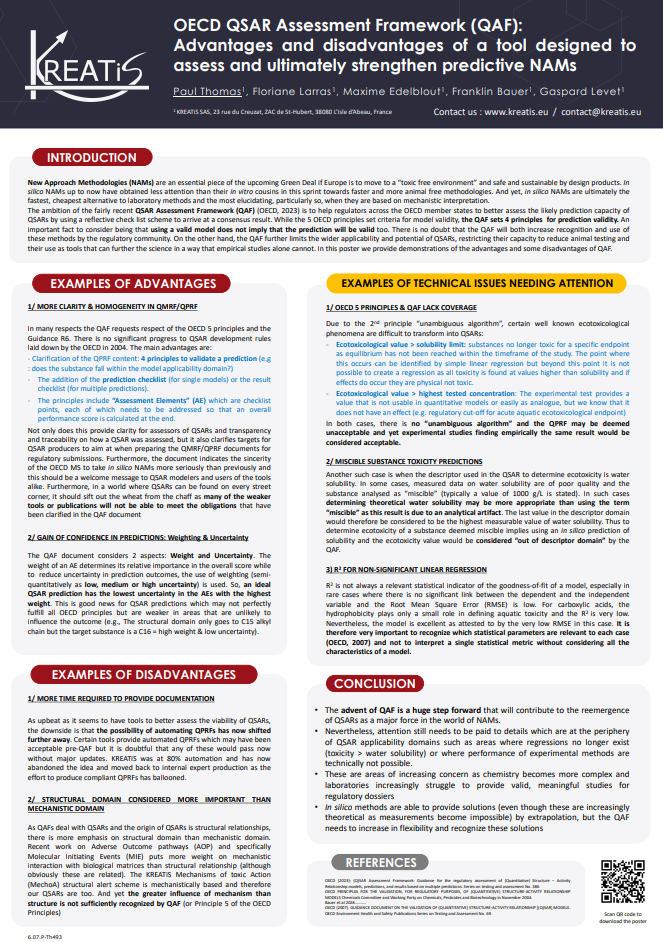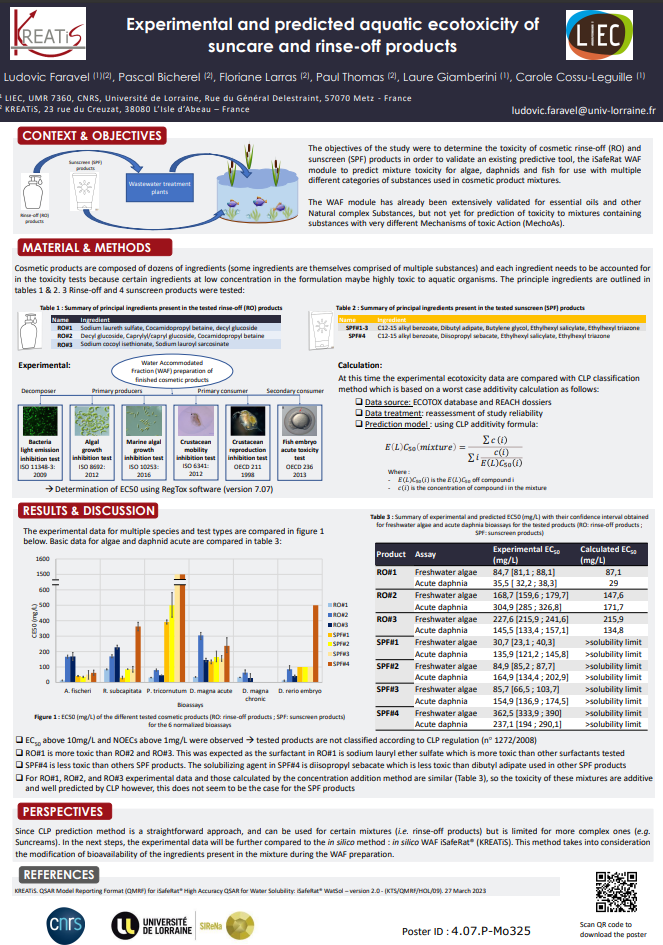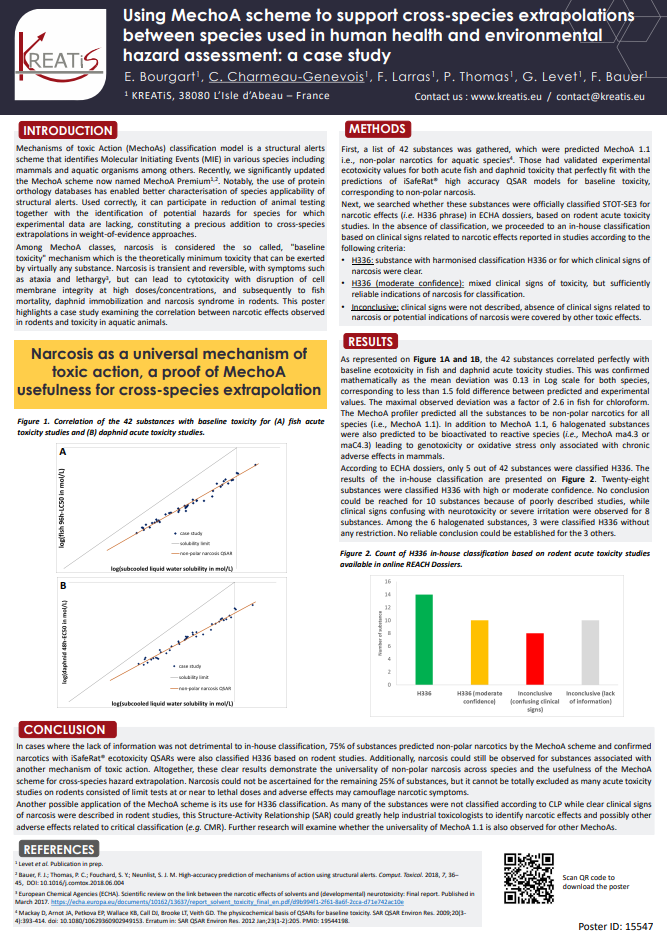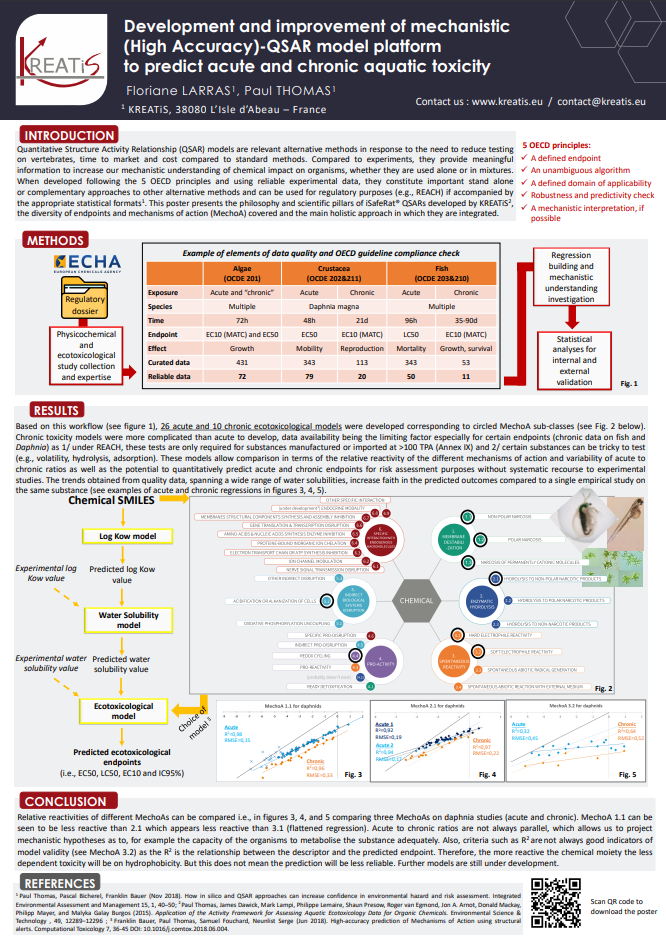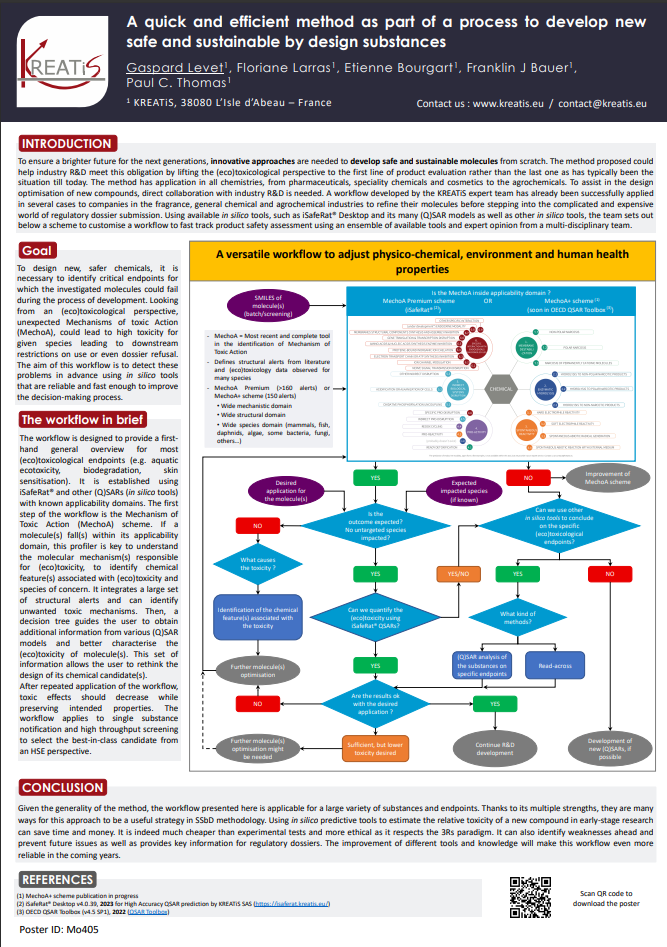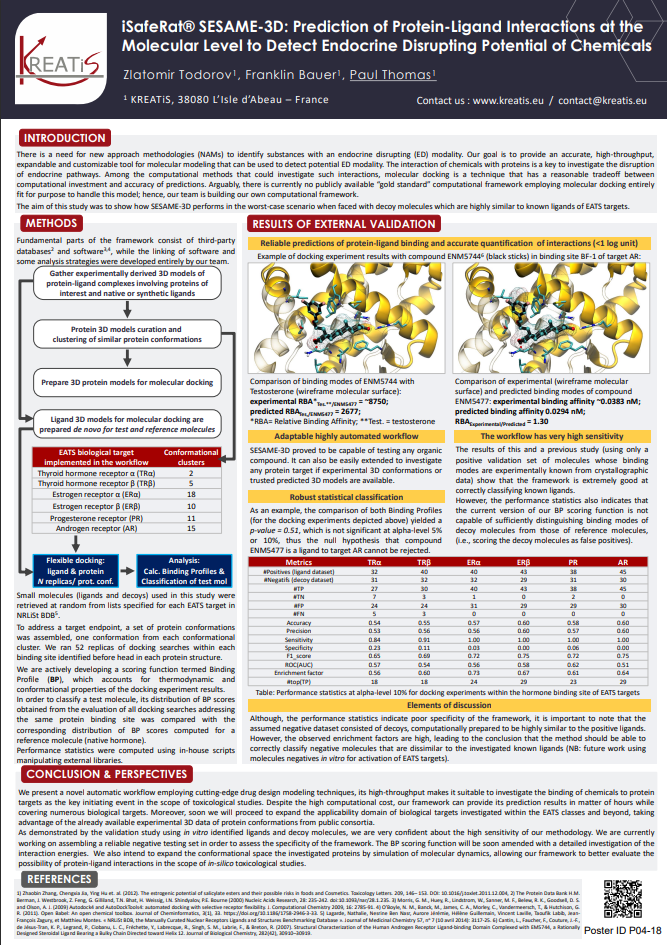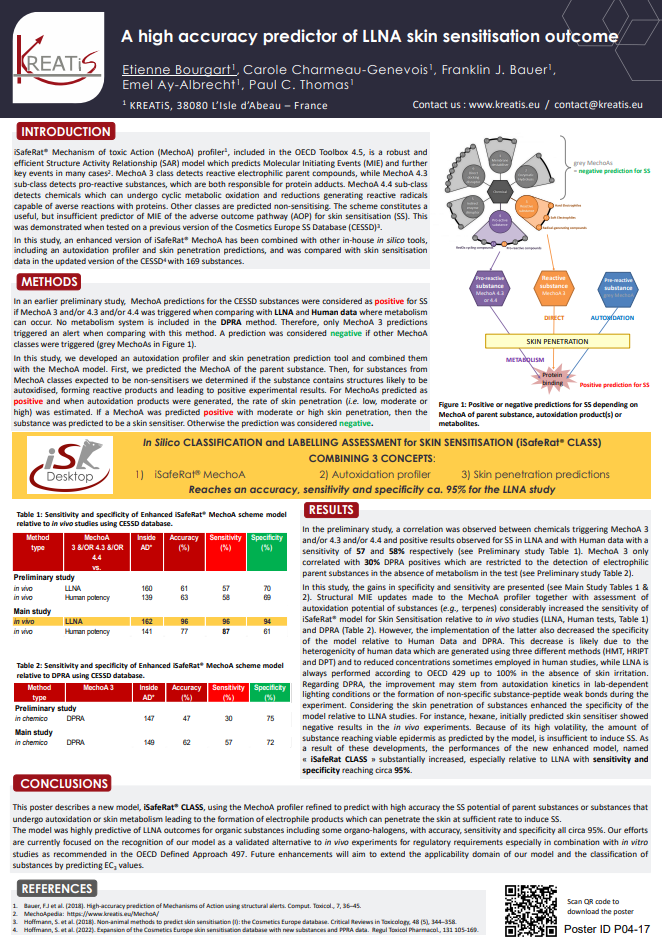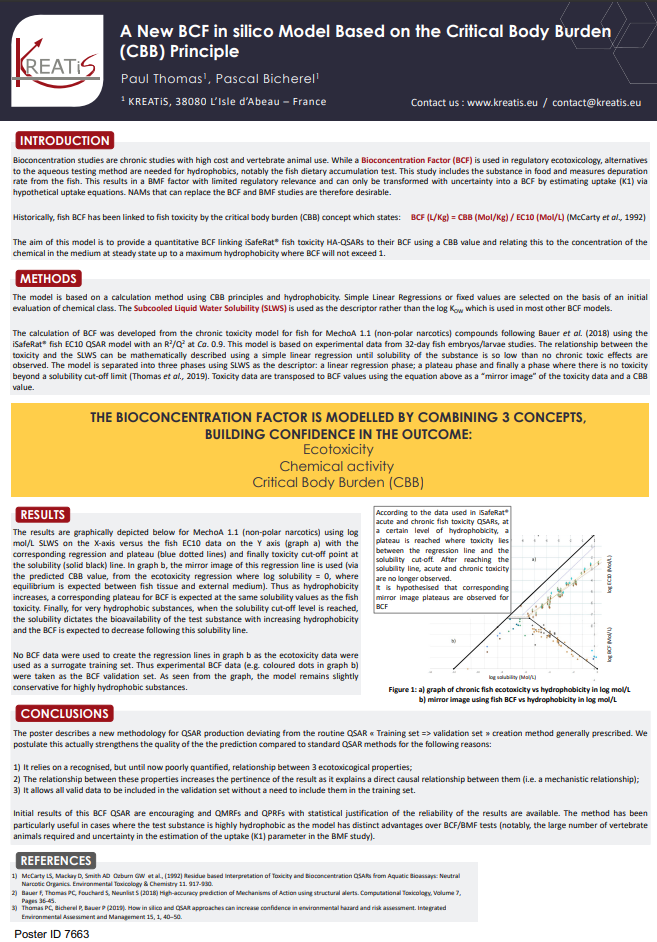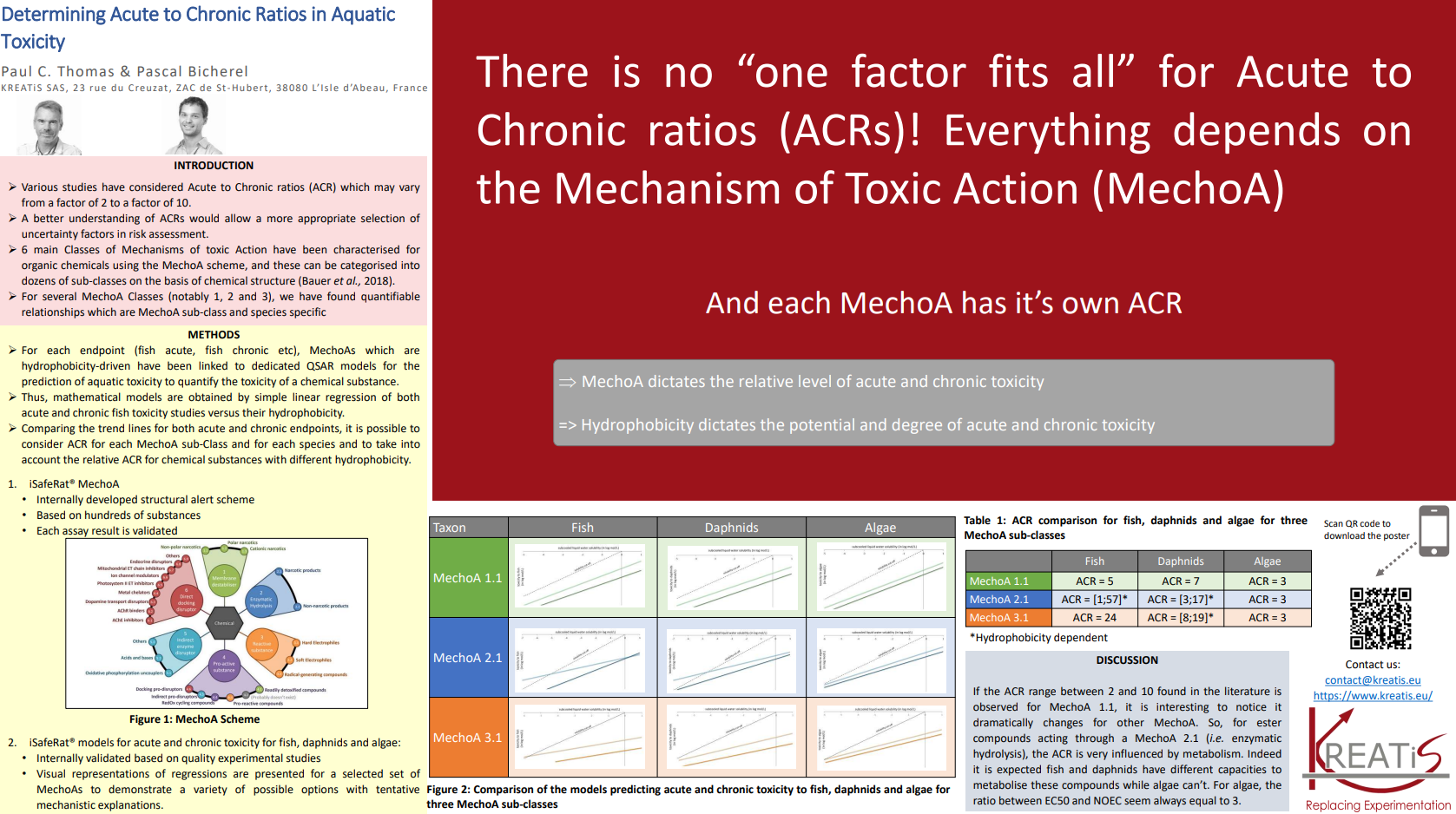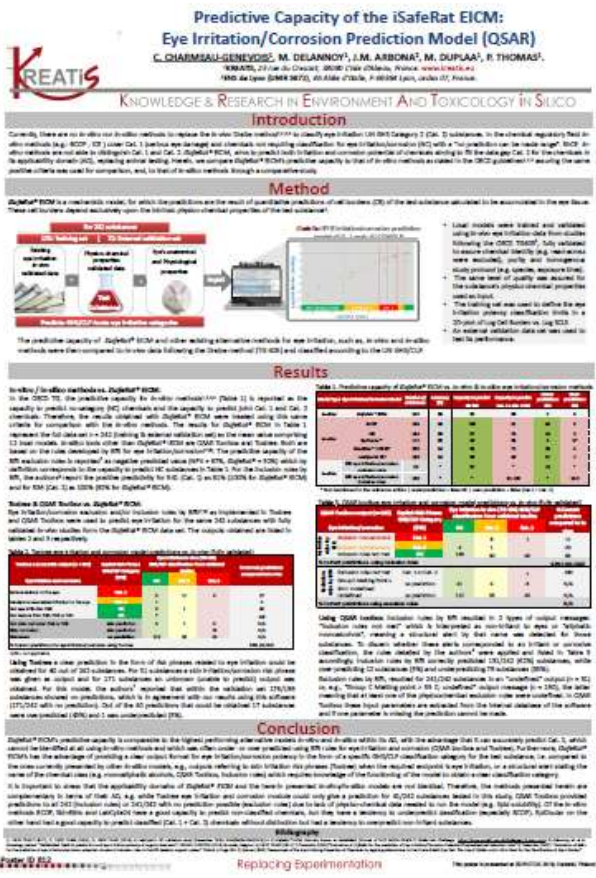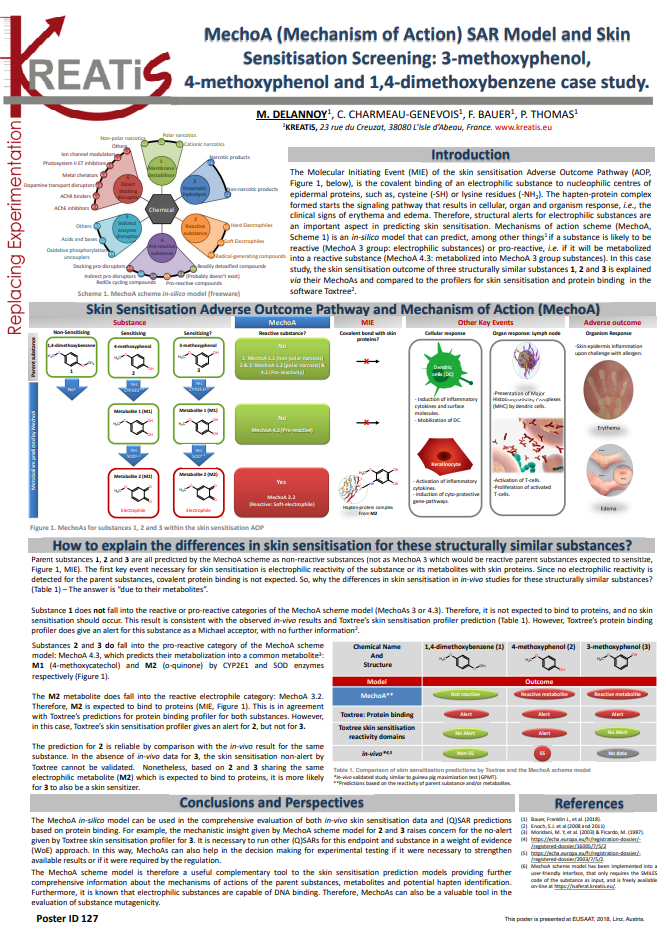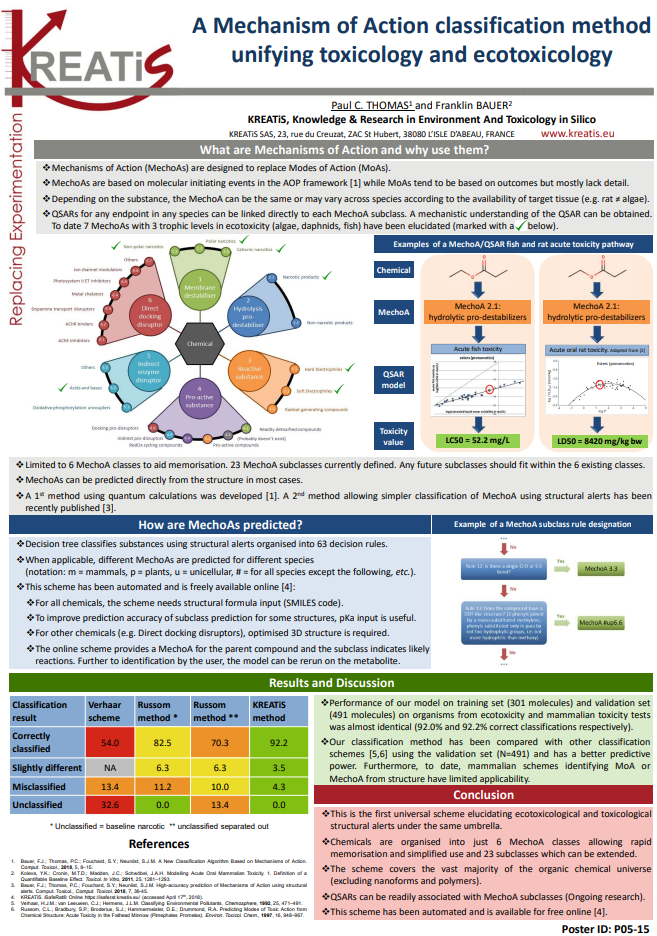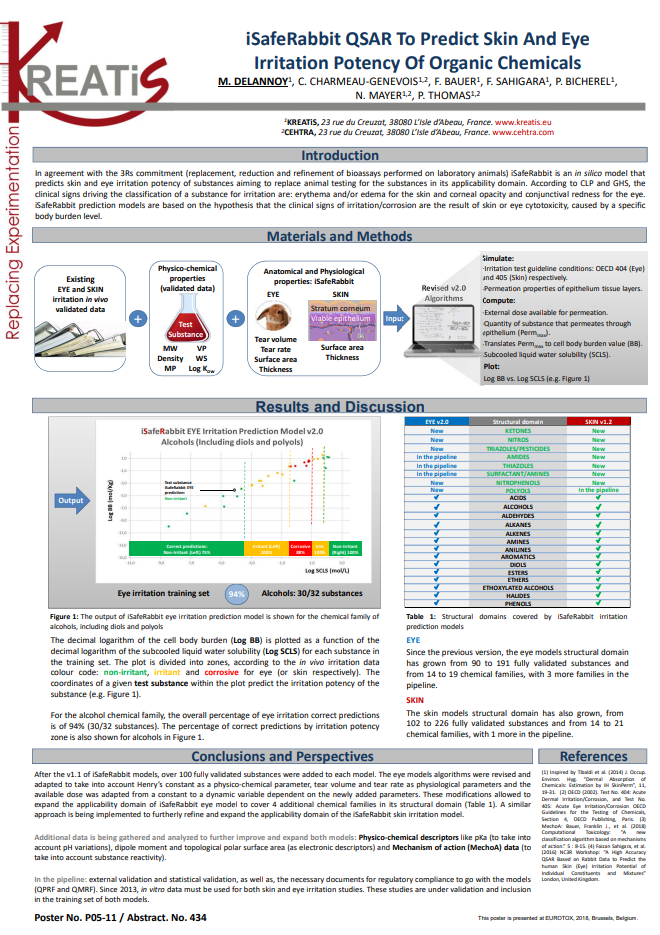Posters
KREATiS often participate in scientific congress. In this section you will find exhibited congress posters featuring KREATiS employees.
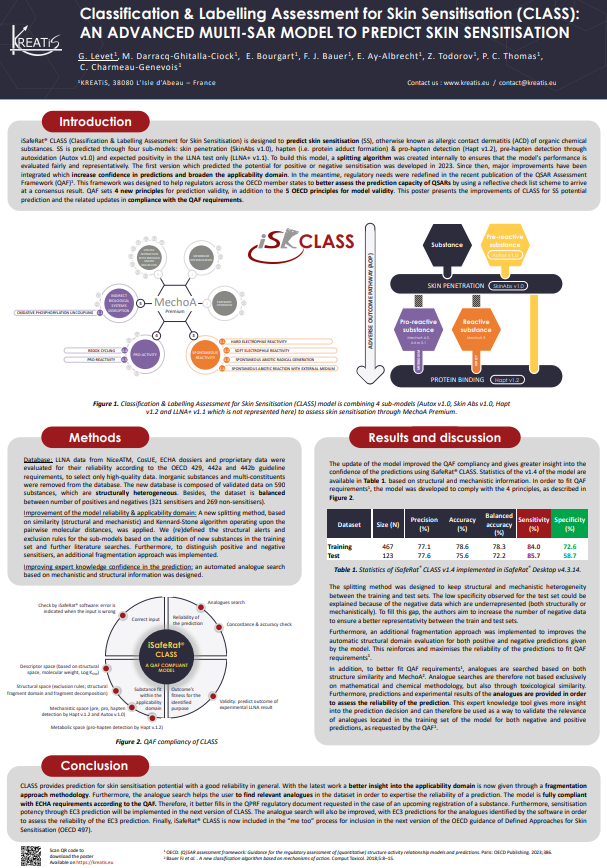
Classification & Labelling Assessment for Skin Sensitisation (CLASS): AN ADVANCED MULTI-SAR MODEL TO PREDICT SKIN SENSITISATION
G. Levet, M. Darracq-Ghitalla-Ciock, E. Bourgart, F. J. Bauer, E. Ay-Albrecht, Z. Todorov, P. C. Thomas, C. Charmeau-GenevoisPresented by Gaspard Levet at EuroQSAR in Barcelona the 24-26th September 2024

Classification & Labelling Assessment for Skin Sensitisation (CLASS) update: a mechanistic in silico model to predict skin sensitisation potential
G. Levet1 , M. Darracq-Ghitalla-Ciock1 , E. Bourgart1 , F. J. Bauer1 , E. Ay-Albrecht1 , Z. Todorov1 , P. C. Thomas1 , C. Charmeau-Genevois1Poster presented by Marie Darracq-Ghitalla-Ciock at Eurotox2024 the 8-11th september 2024 in Copenhagen.
Recent updates to the MechoA scheme, an in-silico tool to support mechanistically-driven read-across approaches
PostersF.J. BAUER, P.C. THOMAS and M. DELANNOY (2020)
Poster SETAC Europe 30th Annual Meeting
A new structural alerts scheme to predict the absence of well-known modes of action for endocrine disruption
PostersF.J. BAUER, Z. TODOROV and P.C. THOMAS (2020)
Poster SETAC Europe 30th Annual Meeting
Molecular modeling for predicting potential endocrine disruption activity of small molecules
PostersZ. TODOROV, C. CHARMEAU-GENEVOIS, P. THOMAS (2019
Eurotox, Helsinky, Finland. Toxicology letters. Volume 314, Supplement 1, 10 October 2019
Predictive capacity of the iSafeRat EICM: eye irritation/corrosion prediction model (QSAR)
PostersC. Charmeau-Genevois, M. Delannoy, J. M. Arbona, M. Duplaa, P. Thomas (2019)
Abstract of the 55st Congress of the European Societies of Toxicology (EUROTOX). Toxicology Letters Volume 314, Supplement 1, 10 October, Page S260
A new in silico method to predict with high probability the absence of potential for endocrine disruption*
PostersP. Thomas, C. Charmeau-Genevois, F.J. Bauer (2019)
Toxicology Letters Volume 314, Supplement 1, 10 October 2019, Page S262-263
What (Q)SAR modelling can tell us about fish toxicity?
Oral presentationsPascal BICHEREL (2019)
Oral presentation from EUSAAT, Linz, Austria
QSAR models in ecotoxicology:why such lack of faith?
Oral presentationsPascal BICHEREL (2019)
SETAC Europa 29th Annual Meeting 2019, Helsinky, Finland

A thermodynamically-based step by step calculation method to assess aquatic toxicity of mixtures
From an environmental perspective chemical substances do not act in the same way as pure substances tested in the lab. Many substances, classified as such under REACH are actually mixtures (i.e. Natural Complex Substances, such as essential oils). Therefore this is a need to understand mixture toxicity and since water is the universal solvent in the environment, aquatic toxicity of mixtures has been of high concern for many years. One recognised way to obtain toxicity data on mixtures was to follow OECD (2000) Guidance No. 23 on difficult substances and mixtures which advocates use of the water-accommodated fraction (WAF) method (i.e. testing the constituents together at specific loading concentrations). Implementation of the WAF method costs time and money.More recently, research has been conducted in order to determine if an additivity approach can be used to predict aquatic toxicity of mixtures of chemicals or whether independent action predominates. Nowadays the favoured hypothesis is the Concentration Addition (CA) where toxic units of mixture constituents with same toxic mode of action can be summed (Loewe and Muischnek, 1926; Backhaus et al., 2003). In this work, the chemical activity concept has been used to normalise the relative part of toxicity of each constituent (Mackay et al., 2009; Thomas et al., 2015). Schmidt et al. (2013) and Smith et al. (2013) have both shown that aquatic and terrestrial ecotoxicity can be determined by using summing constituent activities of sub-lethal levels of constituents in a mixture comprised of solid PAHs. However unlike solids compounds (Banerjee et al., 1984), liquids partition into each other thus reducing the overall toxicity of the mixture. Therefore the initial rule of CA modified according to the chemical activity has also to be completed by an additional step where the non-bioavailability phase is remove from the calculation. Based on thermodynamic liquid-liquid equilibrium, aquatic toxicity can finally be accurately calculated for mixtures of liquid hydrophobic compounds, like essential oils. This method can provide results within a factor of 2 of experimental results while the CLP additivity method results are at least a factor of 10 lower.

A unique QSAR model to determine microorganism toxicity in activated sewage sludge
Toxicity of microorganisms, usually following the Activated Sludge Respiration Inhibition Test (ASRIT) – OECD guideline 209 is a required endpoint in fulfilment of Annex VIII in REACH dossiers i.e. substances produced in quantities >10 TPA. Physicochemical properties (like adsorption to sludge or volatility) as well as the lack of obligation for analytical quantification makes it difficult to perform this test for some substances and interpretation can be ambiguous. In order to replace this kind of experimentation a High-Accuracy QSAR model has been developed. This work has been carried out as a part of the DAMIER project, a French funded project for the development and the use of High Accuracy QSAR models for REACH compliance. Therefore the model meets the five OECD principles (OECD, 2004) and has been validated to provide accurate EC50 values for non-polar narcotic substances. The algorithm is based on a simple linear relationship which links toxicity to activated sludge microorganisms to sub-cooled liquid solubility. It is based on the concept that chemical activity expressed through water solubility can explain aquatic toxicity as has previously been shown for fish, invertebrates and algae (Mackay et al., 2009; Thomas et al., 2015). This is the first model in ecotoxicity able to predict such an endpoint for regulation known to the authors.A proposed Method of Determining Environmental Risk of Complex Substances
Oral presentationsPaul THOMAS and Pascal BICHEREL (2018)
Oral presentation SETAC Europe 28th Annual Meeting, 2018, Rome, Italy
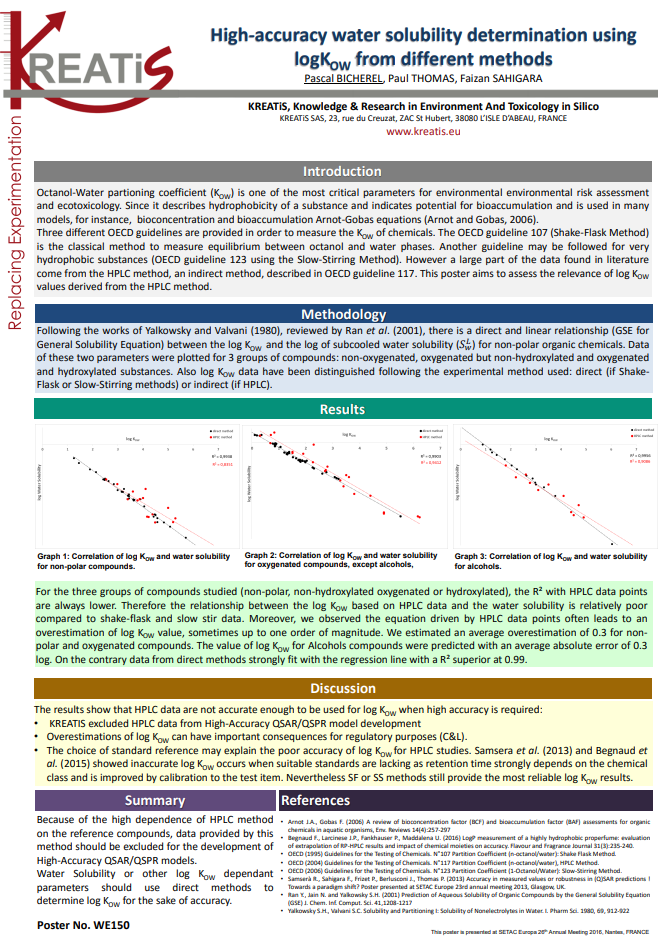
High-accuracy water solubility determination using log Kow from different methods
Work was carried out to determine the relative accuracy of several experimental methods used to determine log KOW values: HPLC (OECD 117); shake flask (OECD 107) and slow-stir (OECD 123). In order to do this log KOW values were plotted against water solubility values. It was found that the method for log KOW determination directly influenced the relationships found between log KOW and water solubility. Water solubility is a parameter which is typically measured with a shake flask method (OECD 105) or improved using a slow-stirring method (derived from OECD 123 for log KOW determination) when water solubility is low. When log KOW data for a group of compounds (e.g. oxygenated substances excluding alcohols and acids) are divided between shake flask and slow-stir methods and compared to results from the HPLC method, goodness-of-fit of correlation are significantly different. Water solubility values correlate better with log KOW values determined using shake flask or slow-stirring methods. However HPLC method overestimates log KOW with an average error of 0.43 log units. HPLC cannot be used as a reliable method to measure log KOW with accuracy and this is also the reason why HPLC data should be excluded as a data source during development of High-Accuracy QSAR models.High Accuracy QSARs for the prediction of acute and chronic aquatic toxicity
The thermodynamic relationship between the chemical activity and the toxicity of narcotic chemicals has recently been hypothesised by Mackay et al in 2009. In 2013, an ECETOC task force carried out an extensive project on a large existing dataset to validate Mackay’s hypothesis that the chemical activity can be used to accurately predict the toxic effects in aquatic species. The task force tentatively proposed a relationship for acute and chronic effects for MoA1 substances and this was recently made available as ECETOC Technical Report 120. Using these data as a starting point, KREATiS extensively reworked these tentative algorithms and created the first High Accuracy QSARs (HA-QSARs) with R2>0.95 for acute ecotoxicity to Fish, Daphnia and Algae.Once the acute toxicity QSAR results had been demonstrated to be at least as accurate as experimental data for MoA1 substances, the work was then extended to MoA2 substances to see if similar levels of accuracy could be obtained. Further work was also initiated on the chronic toxicity endpoints for MoA1 substances (where metabolism and analytical issues could significantly influence the experimental results and therefore accuracy in predictions). Future developments including the understanding of Acute to Chronic Ratios (ACR) will be explored.
Presented at SETAC Europe 25th annual meeting 2015, Barcelona, Spain.
Application of the Activity Framework for Assessing Aquatic Ecotoxicology Data for Organic Chemicals
Toxicological research in the 1930s gave the first indications of the link between narcotic toxicity and the chemical activity of organic chemicals. More recently, chemical activity has been proposed as a novel exposure parameter that describes the fraction of saturation and that quantifies the potential for partitioning and diffusive uptake. In the present study, more than 2000 acute and chronic algal, aquatic invertebrates and fish toxicity data, as well as water solubility and melting point values, were collected from a series of sources. The data were critically reviewed and grouped by mode of action. 660 toxicity data were considered to be of acceptable quality. The 328 data which applied to the 72 substances identified as MoA 1 were then evaluated within the activity-toxicity framework: EC50 and LC50 values for all three taxa correlated generally well with (subcooled) liquid solubilities. Acute toxicity was typically exerted within the chemical activity range of 0.01 to 0.1, while chronic toxicity was exerted in the range of 0.001 to 0.01. These results confirm that chemical activity has the potential to contribute to the determination, interpretation and prediction of toxicity to aquatic organisms. It also has the potential to enhance regulation of organic chemicals by linking results from laboratory tests, monitoring and modelling programs. The framework can provide an additional line of evidence for assessing aquatic toxicity, for improving the design of toxicity tests, reducing animal usage and addressing chemical mixtures.Use of High Accuracy QSARs for reliable regulatory endpoint predictions and further uses in environmental risk assessment
Despite the growing popularity of in-silico approaches as an alternative to replace animal testing, the majority of existing QSAR models have been designed for screening purposes and are therefore considered unacceptable to replace experimental studies due to lack of precision and strict validation. KREATiS has developed a series of High Accuracy QSARs (termed HA-QSARs) based on the strong and recognised relationship between fugacity, chemical activity and toxicity for narcotic substances (MoA 1 and 2). These thermodynamically sound HA-QSARs for various physicochemical and ecotoxicological endpoints are interlinked within a cascade approach, where each endpoint (eg. Water Solubility) can be determined from another endpoint (eg. log KOW) providing results as good as those from quality experimental studies. This poster will provide an overview of how these HA-QSARs are generated implementing the Good Modelling Practice (GMoP) and validated following OECD principles. Using this cascade approach as a case study, it will be shown how the use of HA-QSARs could be extended to validate or invalidate the experimental study results and how this approach could be an interesting tool to explore other areas of concern in ecotoxicology such as Acute to Chronic Ratios (ACRs).Presented at SETAC North America 36th Annual Meeting 2015, Salt Lake City, Utah, USA

DAMIER – A research project for the development and application of high accuracy in-silico models for REACH
Despite recommendations by the European Chemicals Agency (ECHA) to use in-silico approaches as an alternative to replace animal testing, the majority of existing QSAR models have been designed for screening purposes and are therefore considered unacceptable to replace experimental studies due to lack of accuracy and strict validation. This was the basis for proposing DAMIER (stands for Développement et applications de modèles informatiques pour REACH) research project which was funded in 2014 under the 17th French FUI (Fonds Unique Interministeriel) call for projects. The objective of the DAMIER project is to replace current experimental studies needed for chemicals registration under REACH regulation using computer modelling of physicochemical and ecotoxicological properties. This work will involve the development of High Accuracy Quantitative Structure-Activity Relationship (HA-QSAR) models for numerous REACH annex VII and VIII endpoints. All the HA-QSARs developed under this project will be validated following the recommended five OECD principles for QSAR models.This poster will provide an overview of the various research activities allocated over a timeframe of three years amongst all the five project partners (Two SMEs, KREATiS (co-ordinator) and Processium; the Institut des Sciences Analytiques (ISA); the Laboratoires des Pyrénées et des Landes (LPL) and Rovaltain Research Company). A workflow will be provided to get a better understanding of the collaboration within the project partners, in particular how the laboratory-based work will be carried out throughout the project work to support the development and demonstrate the validation of DAMIER HA-QSARs, (for instance, procuration of data from new, innovative and reliable experimental methods, some of which generated by DAMIER). Finally, an overview of the validation strategy of these models will be provided to make them suitable for registration purposes under REACH.
Presented at SETAC Europe 25th annual meeting 2015, Barcelona, Spain.
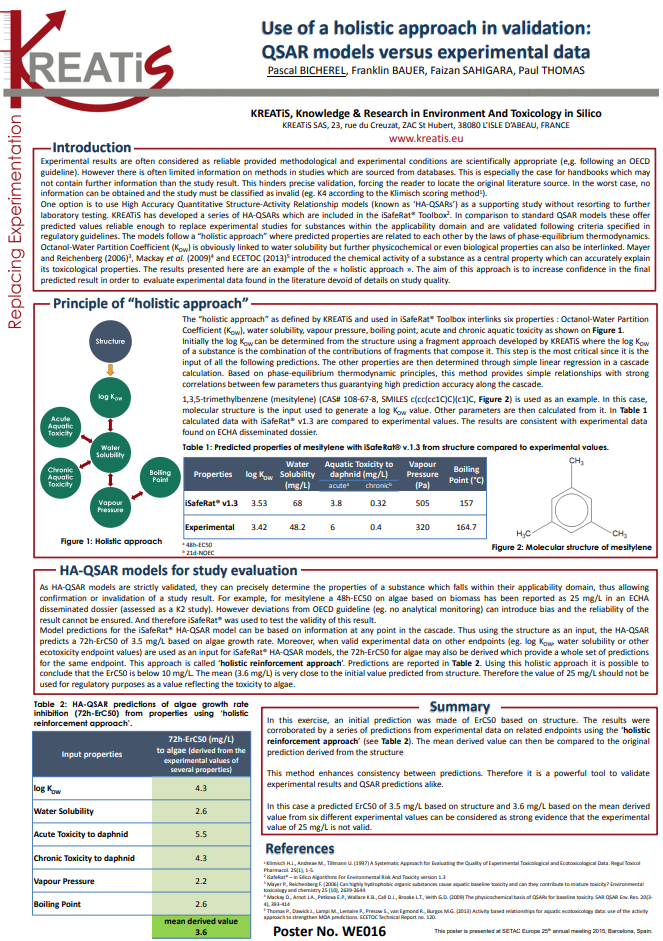
Use of a holistic approach in validation:QSAR models versus experimental data
There is a strong and recognised relationship between fugacity, chemical activity and toxicity for narcotic substances (MoA 1 and 2). High Accuracy Quantitative Structure Activity Relationships models (HA-QSARs) have been developed such that these thermodynamic laws are embedded in the algorithms. Thus using a cascade approach each endpoint (eg. Water Solubility) can be determined from another endpoint (eg. log KOW) providing results as good as those from quality experimental studies.One of the uses of HA-QSARs is to use a combination of several experimental endpoint values (eg. fish and algae toxicity, log KOW and water solubility) to calculate a thermodynamically related endpoint (eg. daphnid toxicity) thereby creating a set of results for the same endpoint.
By combining the accuracy of the model and the reliability of the original experimental values, this method, called “the holistic approach”, can be used to validate or invalidate experimental studies. This approach can also be used as a powerful tool to increase accuracy and validate HA-QSARs. Case studies are provided.
Presented at SETAC Europe 25th annual meeting 2015, Barcelona, Spain.
The use of High Accuracy QSAR models in high level testing.
Micro/Mesocosm systems have added much to the existing knowledge of ecologists facilitating a better understanding of the interactions, fate and effects within ecosystems. Moreover, enclosed model ecosystems are becoming a major research tool for soil/sediment ecologists because of the high degree of control of test parameters (light, heat, pH, hygrometry…) that these systems allow compared to conventional methods. Despite being an efficient methodology to mimic fieldexperiments, micro and mesocosms are associated with several drawbacks, for instance the identification of correct dose levels which would result in effects needed to determine the interactions which would be found in natural ecosystems and the reliable extrapolation of laboratory based ecosystems to the field experiments1. Insilico alternatives including Quantitative Structure Activity Relationships (QSARs) have been proposed in the recent years in response to the EU initiatives to minimize animal testing by replacing them with suitable and reliable approaches. QSARs are based on the principle that similar chemical structures can lead to similar biological activities and are commonly applied in the ecotoxicological risk assessment to evaluate the fate of chemicals in the environment. Recently, KREATiS developed a series of QSAR models called ‘HA-QSARs’ included in it’s iSafeRat Toolbox2 which in comparison to standard QSARs offers predicted values reliable enough to replace experimental studies and validated following the criteria specified in regulatory guidelines. The aim of this poster is to provide an introduction to the methodology for development and validation of HA-QSARs and briefly present ways in which such models of high precision can be fruitfully used to provide input data to help overcome the some of the above limitations in experimentation and achieve the best possible quality studies.
Presented during October 2014 at the 1st scientific meeting of the Rovaltain Foundation, Alixan, France.
A new model to perform high accuracy calculations of aquatic toxicity for mixtures.
Toxicity of multi-constituent substances can be experimentally assessed following the OECD Guidance 23 describing adaptations of the standard methods to test water-accommodated fractions (WAFs), where the different constituents of a mixture are tested together at a specific loading rate. The problem with the method is that, unlike studies on single substances, it is difficult to validate the results based on measured concentrations. There is a need for a recognized calculation method to determine the acute ecotoxicity of mixture using the values of E(L)C50 of each constituent anticipating the analytical variability of each loading rate based on thermodynamic principles. One such method is a calculation proposed by the CLP Regulation. However this method is too conservative and can lead to misclassification of the substance. The iSafeRat® method is a mechanistically derived, accurate calculation for WAF toxicity and its validation is described below.Presented at SETAC Europe World Congress 2014, Basel SWITZERLAND
Activity based relationships for aquatic ecotoxicology data: use of the activity approach to strengthen MoA predictions
The relationship between Chemical Activities (as defined by phase equilibrium thermodynamics) and toxicity of narcotic chemicals was originally hypothesised at the end of the 1930s but has only recently been reanimated (Mayer & Reichenberg (2006); Mackay et al. (2009)). This study focussed on the approach used by these authors taking data from an existing, presumed valid database (ECHA disseminated database of the REACH Phase I dossiers), to explore the approach and verify the results from the MacKay et al. model.Presented at SETAC Europe World Congress 2013, Glasgow UK
Chemical substance solubilities in mixtures: not so simple
Mixtures and mixture toxicity is of current environmental concern as actual aqueous concentrations of each constituent and therefore the toxicity of the mixture cannot be readily predicted. The aim of this poster is to present recent work on insilico methods to predict aqueous concentrations of complex mixtures and their subsequent toxicity to aquatic organisms which may ultimately allow us to replace both WAF and CLP methods.Presented at SETAC Europe World Congress 2013, Glasgow UK
Improved OECD 105 water solubility test design
Water solubility is one of the critical parameters of water chemistry required for ecotoxicological risk assessment of chemical substances. The OECD 105 Guideline comprises two methods, the shake flask method for water soluble substances (liquids or solids) and the column elution method for poorly soluble solids (despite the fact that liquids are not formally excluded, the column elution is often not technically feasible, due to clogging for example). A method is proposed incorporating a simple modification that is imported from another OECD Guideline (OECD 123) which can be used to improve solubility determinations for poorly soluble liquids and provide reliable indications of true solubility in aqueous media.Presented at SETAC Europe World Congress 2012, Berlin GERMANY
MechoA (Mechanism of Action) SAR Model and Skin Sensitisation Screening: 3-methoxyphenol, 4-methoxyphenol and 1,4-dimethoxybenze
PostersM. DELANNOY, C. CHARMEAU-GENEVOIS, F. BAUER, P. THOMAS (2018)
Poster EUSAAT 2018. Poster EUSAAT, 2018, Linz, Austria
Alternative approaches: how Firmenich has used the 3Rs to reduce the number of fish for REACH submissions
PostersSylvia GIMENO, Julie CENA, Damien CARSON, Pauline REMUZAT, Paul THOMAS (2018)
Poster SETAC Europe 28th Annual Meeting, 2018, Rome, Italy
DAMIER - A research project for the development and application of high accuracy in-silico models for REACH
PostersPaul THOMAS, Pascal BICHEREL, Pascal ROUSSEAUX, Hector OSUNA, Jean-Baptiste DELAFOSSE, Steve KENT, David LEJON, Sylvie BETAT, Nicolas DELPIT, Emmanuelle VUILLET (2015)
Poster, SETAC Europe 25th annual meeting 2015, Barcelona, Spain
A new classification method for mechanisms of toxic action
PostersFranklin Bauer, Paul Thomas (May 2018)
Poster ET&C. Poster SETAC Europe 28th Annual Meeting, 2018, Rome, Italy
Using mechanisms of toxic action to classify and predict ester ecotoxicity
PostersPascal Bicherel, Franklin Bauer, Paul Thomas (May 2018)
Poster SETAC Europe 28th Annual Meeting, 2018, Rome, Italy
Long term ecotoxicity testing of limonene for hazard classification: not such a lemon after all
PostersPaul Christopher Thomas, Froukje Balk, Hans van Bergen, Anja Kamper (May 2018)
Poster SETAC Europe 28th Annual Meeting Rome, Italy
iSafeRabbit® QSAR to predict skin and eye irritation potency of organic chemicals
PostersM. Delannoy, Carole Charmeau-Genevois, Franklin Bauer, Paul Thomas (Sep 2018)
Poster Eurotox Brussels, Belgium. Abstract of the 54th Congress of the European Societies of Toxicology (EUROTOX). Toxicology Letters Volume 295
MechoAs: a new classification scheme unifying human health and ecotoxicology, supporting non-animal testing approaches. example
PostersF. BAUER, P. BICHEREL, P.C. THOMAS (2019)
Poster SETAC EU 28th annual meeting, Helsinki, Finland
